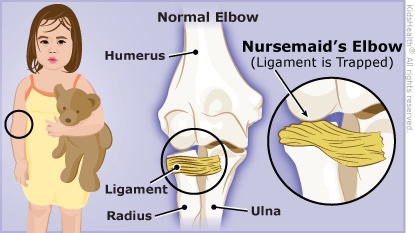Nursemaid's Elbow: How to Care for Your Child
Nursemaid's elbow happens when a ligament (a stretchy band that joins two bones) gets trapped. The health care professional did a quick and gentle move to get the ligament back into place. Your child is not yet moving the arm fully. The splint is there to support and protect the elbow until your child can see an orthopedic specialist (bone specialist).


-
Make a follow-up appointment with the orthopedic specialist as recommended.
-
If your child has pain, a medicine may help. If your health care professional says it's OK, use these medicines exactly as directed:
-
acetaminophen (such as Tylenol® or a store brand)OR
-
ibuprofen (such as Advil®, Motrin®, or a store brand). Do not give to babies under 6 months old.
Daily splint care:
-
Leave the splint in place until you see the orthopedic specialist.
-
Encourage your child to wiggle the fingers once in a while to keep blood moving normally.
-
Make sure your child doesn't pick at the lining of the splint or scratch under the splint.
-
Keep dirt, sand, lotion, and powder away from the splint.
-
Make sure your child doesn't put toys, food, or other objects in the splint.
-
Check the area around the splint for scratched skin.
-
Make sure the fingers aren't pale, blue, numb, or tingling.
-
If your child was given a sling, use it only when your child is awake.
-
Keep the splint dry:
-
No swimming.
-
Give sponge baths to kids younger than 5 years old.
-
Older kids should take baths instead of showers. Put a plastic covering over the splint and keep it completely out of the water.
-
If the splint gets splashed, gently blow air onto it using a hair dryer on the cool setting.
Problems to watch for:
-
Itching: Tap lightly on the splint or use a hair dryer on the cool setting to blow air in and around the edges.
-
Swelling: If fingers look puffy, raise the arm above the level of the heart for 1 hour. If swelling doesn't get better, call your health care professional.

-
Your child's pain isn't better after taking pain medicine.
-
The pain becomes worse, especially when your child stretches out the fingers.
-
The fingers are swollen and do not get better after raising the arm above the level of the heart for 1 hour.
-
Your child develops a fever without an obvious cause (like an ear infection or sore throat).
-
There are blisters, rashes, or raw spots on the skin around the splint.
-
The splint feels too tight or too loose.
-
The splint becomes damaged, wet, or smelly.

-
Your child develops severe pain in the arm.
-
Your child's fingers turn numb, pale, or blue.

How do kids get nursemaid's elbow? Young kids have ligaments that are a bit loose. Sometimes during play or when a child is lifted by the arm, two bones in the elbow can briefly separate a little bit, letting a ligament slip into the joint and get stuck. As kids get older, the ligaments tighten. Most won't get nursemaid's elbow after they turn 5 years old, though it can happen up to age 6 or 7.
How do health care professionals diagnose nursemaid's elbow? Health care professionals are trained to examine a child's arm and ask questions about how the injury happened. They usually don't need to do any special tests to diagnose nursemaid's elbow.
Why does my child have a splint? If a child still won't move the elbow after the movement is done to get the ligament back in place, it might be a sign that something else is wrong.
If the health care professional suspected a broken bone, he or she may have done X-rays. Even if the X-rays didn't show a broken bone, putting a splint (a partial cast) on the arm will protect it until your child can see a specialist.
After the specialist takes off the splint, your child should start to use the arm normally. If not, the specialist will check for other problems.
Can kids get nursemaid's elbow more than once? Yes. To help prevent it, parents and caregivers should never pull, tug, or swing a child by the arms or hands. Some kids, though, are just more likely to get nursemaid's elbow, and might get it again even when parents try hard to prevent it.